Trisuit Shootout Part 1: Kiwami
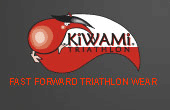
If you’re not a fan of ITU racing, Kiwami’s trisuits may definitely be flying underneath your radar. And even if you are a fan, you may not recognize the name, but you’ll definitely recognize the suit. Of the six medalists at the recent ITU World Championships, three of them were wearing Kiwami suits, but only one of them was actually a Kiwami-sponsored athlete. Both gold medal winning suits – Daniel Unger’s “ASICS” suit, Vanessa Fernades’ “ONDA” suit – are actually made by the same company that makes Laura Bennett’s suit – Kiwami. Founded in 2003 by New Zealand’s Craig Watson and France’s Helene Salomon, Kiwami makes what are easily the most popular suits on the ITU circuit. It’s quite something to see the leaders coming off the bike wearing ASICS, adidas, and Nike suits that somehow all look exactly the same except for the color swatches. Many of these companies make race suits, at least for their pro athletes, so what is it that causes so many of these athletes to choose the same suit? That’s the question I wanted to answer, and Craig Watson was nice enough to send me all three of his men’s trisuits so I could see for myself why this suit is so ubiquitous within the pro ranks of ITU racing.
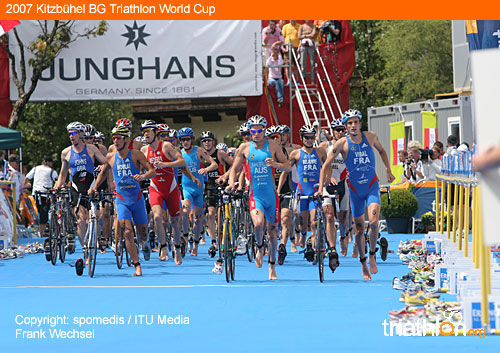
Kiwami makes triathlon clothing and nothing else. No bike shorts. No jerseys. No jackets. The only non-race apparel are men’s and women’s t-shirts, and a swim cap. Other than that, everything is triathlon specific apparel. The three suits they make are the long-course specific Kaiman, which has a slew of pockets, as well as both wider shoulders and a larger, slightly larger pad than the “universal” A-Suit. The A-Suit is a back-zip suit, with no pockets and a moderate sized pad that is Kiwami’s answer to the “basic trisuit.” Both it and the Kaiman are made primarily of Lycra. Both of these suits are very nice, but they are basically just very nice versions of something that we’ve all seen and worn before. Yes, the cut is nice. Yes, the stitching and colors are first rate. But basically, they are Lycra suits. What makes Kiwami really noteworthy is the pinnacle of their line – the Amphibian. This is the suit that the ITU athletes love (Female athletes can love their women’s “Wahina Max”).
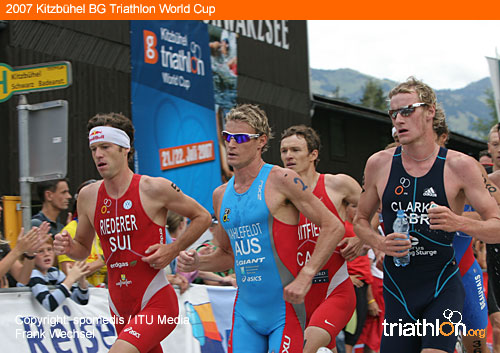
The Amphibian is cut exactly the same as the A-Suit but has no pad and is made of a unique “Oxygene-Hydrofuge” material. Unique? Ha. That is just a marketing term. At least, I thought it was, until I tried to get the Amphibian wet. And I tried hard. But I couldn’t. I’m used to seeing these Teflon-coated Lycra suits bead up when you splash some water on them at the start line. But I’ve never seen a suit bead up after swimming in it for 15 minutes. At least, I hadn’t. But, after a good open water set, enough to soak both of the Lycra suits thoroughly, I emerged from the water with my suit basically as dry as I’d started. The fabric is a polyester/elastene blend (as opposed to polyamide/elastene blend for Lycra), and it feels a lot like tissue paper, quite unlike the “silky” feeling of Lycra. One swimmer I spoke with said it reminded them of the old “paper suits” that predated Fastskins and the modern competition swimsuits. It makes for an extremely comfortable suit, since there is no clamminess, it wicks sweat away very quickly and dries extremely fast since it takes on so little water.
Not content to leave you, the Slowtwitch populace, with such subjective information, I decided to figure out just how dry the Amphibian stays compared with a Teflon-coated Lycra suit.
Dry weight of each suit (all size Medium):
Amphibian: 109g (for reference, an iPod nano weighs 45g) [according to Kiwami, this makes it the lightest trisuit in the world, even among other suits without pads. We’ll test this claim over the course of these reviews]
A-Suit: 151g
Kaiman: 215g
Weight after 12 minutes agitated wash in cold-water (no detergent):
Amphibian: 196g
A-Suit: 496g
Kaiman: 632g
Weight after spin cycle:
Amphibian: 147g
A-Suit: 209g
Kaiman: 286g
That’s pretty amazing, I think. The fabric really does perform very differently. I hope this is helpful, since quantifying something like “dryness” or “wickability” is hard. I used my Sunbeam kitchen scale to measure all the suits, measured inside a Tupperware container (tared) to keep the suits from spilling over the edge.
In my excitement over the coolness of the Amphibian, I did sort of gloss over what probably matters more to you, which is fit and finish. I’m sorry. It was just really, really cool. So I’ll cover that now.
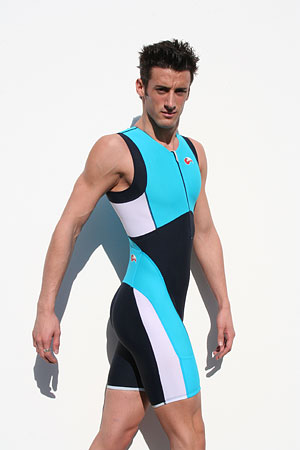
Kiwami subscribes, based on my experience, to the idea of comfort through freedom. This is in contrast to comfort through support. Think boxers vs. briefs. Both comfy, but for different reasons. The Kaiman features a single panel from the bottom of the leg to just under the chest, and as wide as the middle of both thighs. The A-Suit and Amphibian have a single panel from the crotch area up to the chest, and to thigh panels that come up high on the hips on the side (think a women’s bathing suit with legs). In both cases, there is no seam across your waist, a pattern decision which I find very nice. Both patterns are also clearly designed for the different event distances, but they all feel very much like you aren’t wearing anything (as opposed to some suits which are comfortable because of they way they really support your muscles or, uhm, your family jewels). When there does need to be a seam, it is placed somewhere that tends not to move a lot (such as the center of your chest or underneath your pectorals). I wasn’t about to go race an Ironman to test them out, but there was no chaffing at all during swim, bike, or run workouts in any of the suits. The “free” cut is clearly a pattern decision, and if you like that style, you’ll love these suits. If you like more of the “athletic supporter” fit of a brief, these may not be the best suits for you; this is a pretty personal decision, so I’m hoping you know which category you fall into, as it doesn’t seem right to rate the suits based on my preferences. The materials are all outstanding, with the unique hydrofuge material being a real show-stopper. Colors as well are excellent, both in terms of quality of each color and the pairings Kiwami chooses; the suits look sharp, with my personal favorite pairings being the Royal Blue & White (Savoia & Bianco) and Navy Blue & Baby Blue (Marino & Laguna). One more note on colors (thank you to all the readers who've prompted me to make some additions to the article) – each of the Kiwami suit has at least one color option where the main part of the back of the suit is white. For riding in hot weather, this definitely feels cooler, though I didn't ride around with a temperature probe on my back to actual test if it was. Maybe next time…
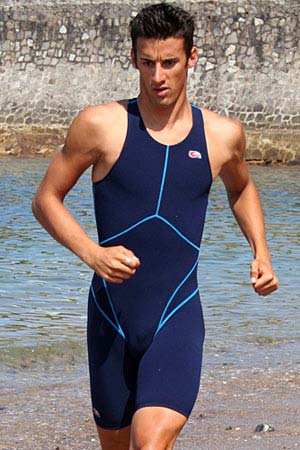
Now onto the suits themselves. The patterns are quite different between the long-course Kaiman and short-course Amphibian and A-Suit, with a lot more going on than just the addition or removal of some pockets to differentiate the two cuts. I’ve tried to cover the important parts of each suit, but if you have more questions, that’s why we’ve got a forum.
The Kaiman is a very free suit, like a pair of boxers (but with an outstanding cycling pad). If you are going to wear something for as many as 17 hours, it’s important that it doesn’t rub you wrong, and this is definitely how this suit is designed. The wide shoulders prevent the suit from pulling on a particular spot, as the pull from stretching the fabric is spread over a wider area. The extra width also means the suit covers more of your back, a welcome relief for those sunny races since sunblock has a nasty habit of sweating off. The Kaiman also has no seams under the armpit, which is a real problem area (in my experience) during long course races. The pockets are well situated, with the traditional back-pockets being easy to get into while exercising, while still holding gels securely; they are also big enough to hold an inner tube (for clincher riders) or a small multitool or CO2 & inflator. One other very nice feature is a relatively high neckline on the Kaiman. The neckline feels a bit higher than on the back-zip suits, but because of the front zipper, you can easily adjust this if it bothers you. The ability to run the neck close high is quite important, however, when riding in the aero-position. This suit experience none of the "billowing" that you see on some suits when you hope onto the bike with a wet suit that suddenly fills up like a parachute (and slows you down like one too).
Unlike the Kaiman, which does well for a long-course suit while swimming, but still doesn’t feel as sleek through the water as the pocketless suits, the A-Suit and Amphibian are clearly designed for athletes that regularly race without a wetsuit. They are outstanding for swimming, with a high neck and a cut that comes way in from the shoulders for a very free stroke without any gaps between the suit and skin for water to enter. They also fit much more snugly than the Kaiman does, which may make them more or less comfortable depending on your preferences. The skinny sections over the top of the shoulder (trapezius, if you want to be technical) were definitely less comfortable, in my opinion, but they allow the suit to cut tight around your chest for a very smooth fit in the water, and for short course racing speed trumps comfort. Comfortable is the suit you win races in. The neckline is slightly lower than on the Kaiman, but the snug cut (and I suspect the back zip helps with this as well, since there are no rigid areas to catch air or water on the front) also means that there is no parachute action when down in the aerobars. For athletes looking for a replacement for the soon-to-be-banned speedsuit, the Kiwami Amphibian is a very fast and legal alternative that is certainly comfortable enough to race an entire half-ironman in (though you’d want something for holding a gel or salt on the run, and I prefer a padded brief underneath for the longer time in the saddle). As just a swim skin, it is certainly more than up to the task, as the does-not-get-wet hydrofuge material seems to provide some measure of buoyancy through the air it traps. Benchmarking speed is pretty tough with swim skins, where the difference is much smaller than between wetsuits, but it’s safe to say the Amphibian is very fast. While these suits perform admirably well during the bike and run, there is a clear focus on the swim, which for short course racing, especially for draft-legal ITU racing, is critical. After that, I think the folks at Kiwami focused on how to make a great swimsuit as comfortable for running as possible. Overall, I think the suits could be more comfortable on the bike, but for running and, especially, swimming, they are outstanding.
All in all, the suits show a tremendous amount of attention to detail. Not only in the fit and finish, but in the patterns themselves. The Kaiman excels on the bike and especially the run, the most important part of a long course race. The A-Suit and Amphibian are geared mostly towards swimming with an additional focus on running. Each suit could be better in the “red-headed step-child” last discipline, but I think Kiwami chose to focus on making the suit work where it counts the most, even if it doesn’t do quite as well in one of the disciplines.
If I had to find a fault with Kiwami’s stuff, it’d be the silicone leg-grippers. I hate these things. And unfortunately, all of the Kiwami suits have them. If you’re thinking about doing a club order, Kiwami does do custom orders, and I’m sure you could get the suits without. But for now, if your buying an off-the-shelf suit, it will have them. I hope Craig changes this, as I don’t think I’m the only one who dislikes these things. Orca had them for a year in 2004, before going back to the style without.
All suits are made in Europe using 100% flat-lock stitching (with not an errant thread of stitch to be found anywhere) and YKK-brand zippers (and yes, this does make a difference).
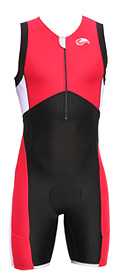
Kaiman
Price: 139 EUR (~196 USD)
Inseam: 19cm (7.5 inches)
Width at the top of the shoulder: 10cm (4 inches)
Pad: Yes. Thin, but firm, with a suede-like covering. Slightly firmer (but not measurably thicker) than the A-Suit. Probably about 1-2mm in thickness. Wider, but doesn’t progress as far forward. Definitely designed for riding in the aero position.
Stitching: 100% flatlock stitching
Zipper: Chest-zip. Opens 33cm (13 inches). Reveals another reflective strip when open.
Materials: Primarily Lycra, with four “mesh” panels – on the side of each leg up to the top of the hip bone and under each armpit to about the bottom of the ribs
Pockets: Six – two leg pockets (one at the bottom of each thigh), two high-hip pockets right above the head of your hip bone (which are more comfortable than they sound), and two large back pockets right over (at least on me) your lumbar vertebrae.
Other features: Reflective striping around each thigh and down the middle of the back. A nice touch for those athletes who finish Ironman races after the sun goes down.
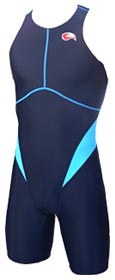
A-Suit
Price: 94 EUR (~132 USD)
Inseam: 19cm (7.5 inches)
Width at the top of the shoulder: 4cm (1.5 inches)
Pad: Yes. Thin, but firm, with a suede-like covering. Slightly less firm than the Kaiman, but similar thickness (about 1-2mm). Longer and narrower than the Kaiman pad, with a seeming preference for road-style riding.
Stitching: 100% flatlock stitching
Zipper: Back-zip. Opens 21cm (8.25 inches). Comes with pull-leash for easy zip-up/zip-down.
Materials: 100% Lycra
Pockets: None
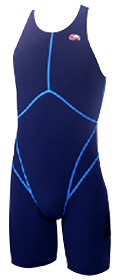
Amphibian
Price: 144 EUR (~203 USD)
Inseam: 19cm (7.5 inches)
Width at the top of the shoulder: 4cm (1.5 inches)
Pad: No. Does feature a patch of material over the inside-front of the crotch, but the more modest athlete might feel better with a swim brief underneath (which is still quite comfortable).
Stitching: 100% flatlock stitching
Zipper: Back-zip. Opens 21cm (8.25 inches) inches. Comes with pull-leash for easy zip-up/zip-down.
Materials: 100% Oxygene-Hydrofuge material in two different forms. The white “back panel” is 82% polyester, vs. 78% polyester for the colored sections. (For reference, Lycra is 78% Polyamide.)
Pockets: None
For more on Kiwami and to see their complete line-up, visit www.kiwami.fr.

